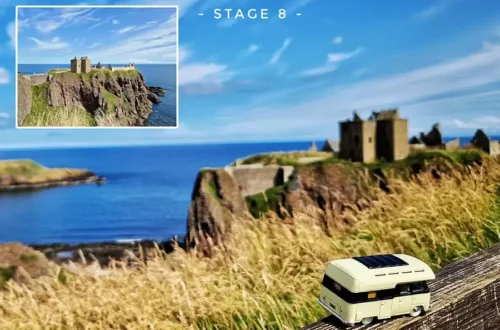
Our Journey through Scotland Ft. M2 Machines VW Double Cab Camper – PART 1
Like a neck breaker...
We write the year 2020. The suitcases are packed, the gas cans filled and the desire to travel increased immeasurably! But then came the pandemic: The Corona wave hit like a bomb, everything changed abruptly. Lockown, travel bans as well as an uncertain future were in store for us. So it actually took 3 years until we could realize the planned trip. For the third time we were going to visit Scotland. Already in 2018 and 2019 we visited the country and were fascinated by the landscapes, castles and the people who carry Scotland in your heart.
For this trip we drove a Volkswagen Double Cab Camper from M2 Machines from 1959. A special production from M2 which is a fully equipped camper with kitchen and sleeping area.
Stage 1: Kirkcaldy

The road led us from Scotland's second largest city Edinburgh to the charming fishing villages of the Peninsula Five. By dual carriageway we crossed the three "Forth Bridges" of the Firth of Forth, one of Edinburgh's most famous landmarks. The Forth Road Bridge was considered a marvel of engineering when it opened in 1964 and was also the longest suspension bridge in Europe. The bridge length of the Queensferry Crossing Bridge seemed to be much longer than planned due to the low maximum speed of the VW camper. We made an intermediate stop at the harbor of Kirkcaldy before we continued towards St. Andrews, Dundee and Pitlochry.
Stage 2: Glamis Castle

We were impressed by the huge Glamis Castle. It is the residence of the Earl of Strathmore, who opened it to the public. So we could park our camper directly in the front garden for an optimal subject. Compared to the camper, however, the building has a few more years on the edge. The castle near Angus was opened in 1372.
Stage 3: Dunalastair House

It became really uncomfortable at the sight of Dunalastair House, or Dunalastair Castle. Dunalastair is an estate in the southern part of the Highlands in Perthshire, Scotland. It is located 18 miles west of the town of Pitlochry on the River Tummel between Tummel Bridge to the east and Kinloch Rannoch to the west and includes part of Dunalastair Water. As a result, it was incredibly difficult to find and almost inaccessible by car. When our camper saw the light of day in 1959, Dunalastair House had already been crumbling for 9 years. A very impressive lost place!
Stage 4: Braemar

Now it was time to make our way to Braemar.
Braemar has its own castle, which is still getting its new coat of paint.
It is located about 93 kilometers west of Aberdeen in the Scottish Highlands.
The Highland Games would have taken place a week after our arrival here, in the presence of King Charles, who was staying at Balmoral Castle not far from Braemar either.
But we were drawn further into the forests of the Cairngorm National Park.
Stage 5: Prince Albert's Cairn

As the name Cairngorm suggests, there are many stone burial mounds here. The cairns commemorate members of the British royal family and events in their lives. One of the most impressive is Prince Albert's Cairn. The largest cairn was erected by Victoria in memory of her husband Prince Albert after his death in 1861. The way was steep up the hillside, but was rewarded with a fantastic view of the Cairngorms National Park as well. There are sixteen stone cairns on the Balmoral estate in Deeside, Scotland, including a single cairn on the adjoining Birkhall estate. The majority of the cairns were erected by Queen Victoria.
Stage 6: Muir

The next stage led to Muir, an area with only a few houses but plenty of hiking trails! The first thing to notice was the ancient bridge that crossed a small gorge. In the gorge itself flows the Dee River, which has its source far to the northwest of the Cairngorms National. The whole scenery was very impressive! Quite lonely, but so are many areas outside the villages of the Highlands.
Stage 7: Crathes Castle

The next milestone was Crathes Castle. The money for this day was only enough to cover the fuel costs, so we had to park the car on the castle wall. The entrance fees for certain castles are quite high. However, you can't blame them, since the upkeep of these imposing structures takes a lot of money!


You May Also Like

